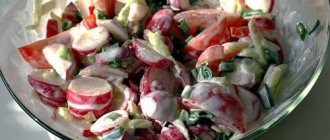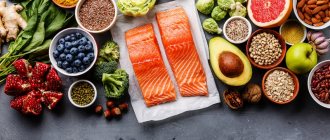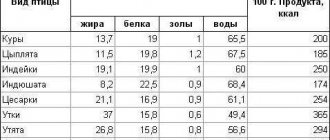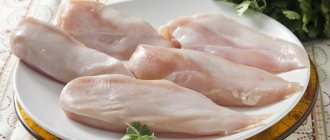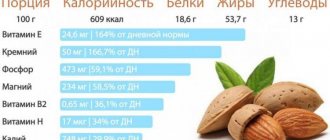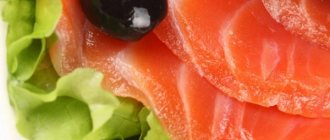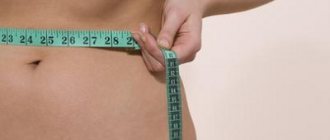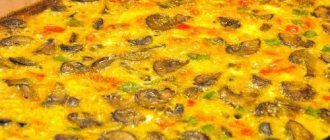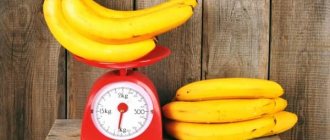How to imagine 100 grams of boiled buckwheat, how much is it, how to understand. How to measure without weighing on a scale, how to measure yourself at home the amount needed for the portion indicated in the recipe by weight in grams.
How to measure a portion of boiled buckwheat, indicated in grams (100 g, g), if we want to do without weighing on scales and measure the product in some other way. For example, when measuring, go the way to get the weight of 100 grams, through the volume. In some cases, it is really convenient to imagine visually what 100 grams of buckwheat porridge looks like from a photo or other image in the picture. Especially if in the photo we see not only the amount of ready-made porridge cooked from buckwheat measured by weight, but also some object located nearby in the photo, the volume of which turns out to be well known to us or familiar to us for culinary activities in the kitchen. Indeed, a photograph of a product placed on the same plate or saucer will not be a very informative image in the picture. This version of a visual image in a photo is very inconvenient. Most often, it is considered a convenient example for measuring buckwheat porridge in grams without scales, the ratio of the amount of product taken by weight to the volume of the glass. Therefore, we can see 100 grams of buckwheat porridge cooked without milk in the photo placed in a glass. Other options, how to understand: how much is 100 grams of boiled buckwheat can be found quite rarely. In this article we propose a different method. More visual and practical than the photo in the glass. It consists of presenting 100 grams of buckwheat porridge in the form of a small table. Where useful ratios of the volumes of containers used in the kitchen and in culinary practice, when preparing dishes according to recipes, are described. What containers and cutlery do we consider the most commonly used for measuring crumbly buckwheat porridge by weight without scales (without weighing) and measuring portions for recipes?
- this is how many teaspoons.
- This is how many tablespoons.
- this is how many 200 ml glasses (cut glass).
- this is how many glasses are 250 ml (standard thin-walled, thin glass).
In some situations that we encounter when we need to measure a portion of ready-made buckwheat porridge cooked in water, we would like to do the recalculation ourselves. For example, convert grams of buckwheat porridge into some other units of volume. For the convenience of site visitors, we have added several more columns (columns) to the table. Now from our table you can find out about 100 grams of buckwheat porridge:
- this is how many liters (l., liter cans).
- this is how many milliliters (ml).
- this is how many cubic centimeters (cm3, cm cubic).
Table 1. How much is 100 grams of boiled buckwheat? The reference data in the table is intended for measuring portions at home without weighing on a scale. And also to convert the weight of granulated sugar indicated in grams into other units of measurement (volume).
How to measure 100 grams (100 gr, 100 g) of boiled buckwheat - this is how many teaspoons and tablespoons.
The first way to measure 100 grams of buckwheat porridge without weighing on a scale is to measure the product using a spoon
. Spoons, tea or table spoons, are convenient because they are always at hand. It is difficult to imagine a kitchen where we would not find this popular “household measuring device”, known to any housewife. It seems to me that no one needs special training to use tablespoons and teaspoons. Although, it is worth explaining that all methods of measuring a product with a tablespoon or teaspoon are always based on the fact that a portion is measured correctly only when we follow one important measurement rule. Which? You need to scoop up the product with a spoon carefully, without a slide. That very mound that is so easily obtained when measuring the product is not a trifle at all and cannot be neglected. It introduces a significant error into any calculations of the quantity of the product, overestimating (increasing) its weight in grams compared to what you expect when measuring yourself at home. It is especially important to follow this rule when measuring portions of loose, grainy, granular, lumpy foods and ready-made dishes. In cases where we want to measure 100 grams (g, g) of liquid, the problem goes away by itself. Since liquids in teaspoons and tablespoons do not create a large slide. And the volume of the measured product will practically coincide with the capacity in milliliters declared by the manufacturer of the spoon. For our table, the following volumes of a tablespoon and a teaspoon are selected:
- The volume of a teaspoon of boiled ready-boiled buckwheat is 5 milliliters (ml), which is 5 cubic centimeters (cm3, cc).
- The volume of a tablespoon of cooked buckwheat is equal to 15 milliliters (ml), which is 15 cubic centimeters (cm3, cc).
The idea of a way to independently measure the weight (mass) of boiled buckwheat equal to 100 grams using a tablespoon or teaspoon
is that there is a proportional relationship between the weight of buckwheat porridge and its volume. Determined from a physical point of view by the bulk density of the product. Bulk density itself, by definition of this physical quantity, is the weight of a certain volume taken per unit. Typically, bulk density, in terms that may be relevant to cooking and measuring portions at home, is the weight of one milliliter (ml). Or, how many grams are in 1 milliliter (ml) of boiled, boiled buckwheat cooked in water without oil. Knowing how many grams 1 ml weighs, we can say exactly how much one teaspoon will weigh and how much 1 tablespoon of buckwheat porridge will weigh in grams. After all, their capacity (volume) is well known to us in advance and we can consider spoons (with some stretch, of course) as standard utensils. This makes it possible for us to use spoons to measure a portion of cooked buckwheat by weight in grams, without weighing it on a scale.
Buckwheat in a tablespoon
Another simple way to measure buckwheat is to sprinkle it with a tablespoon
. Calculate how many grams of buckwheat are in a glass, simply knowing that in a standard tablespoon there is about 19 grams of buckwheat (without a slide). A 250 ml glass holds 11 of these spoons: 11x19 = 209 g.
This way you can measure not only the glass, but also any other container you use. The weight of buckwheat in a spoon can vary from 17 to 23 grams, depending on the moisture content of the cereal and how generously you scoop it into the spoon.
A tablespoon of buckwheat contains 17-23 grams.
Of course, without a scale you will only get an approximate knowledge of how many grams of buckwheat are in a glass. However, this is enough to prepare a delicious dish according to the recipe you choose.
Buckwheat is one of the most popular side dishes in Russia; it’s not for nothing that it was called “Russian bread.” Many have known her since infancy. For a baby's first feeding, doctors usually recommend buckwheat porridge; it is not only a tasty and low-calorie side dish, but also a source of energy, microelements and vitamins.
Not everyone knows how many grams are in a tablespoon of boiled buckwheat, how many vitamins, microelements, and calories it contains, but for many, buckwheat porridge is a dish that gives energy and satiety for a long time.
How many grams of buckwheat in a glass (table)
| A glass of buckwheat | Buckwheat weight in grams |
| Faceted glass of buckwheat until risky (200 ml.) | 170 grams of buckwheat |
| Faceted glass of buckwheat to the brim (250 ml.) | 210 grams of buckwheat |
| A regular glass contains 250 ml. | 210 grams of buckwheat |
| In a tea glass up to the rim (200 ml.) | 170 grams of buckwheat |
| In a plastic glass 100 ml. | 85 grams of buckwheat |
One glass contains 200 ml . holds 170 g of buckwheat (buckwheat)
1 glass contains 250 ml. holds 210 g . buckwheat (buckwheat)
A 100 gram glass holds 85 grams of buckwheat (buckwheat)
Attention! If you need to measure (measure) the exact amount of buckwheat in a small quantity, the easiest way is to use a teaspoon or a tablespoon. In order to use this information, go to the article how many grams of buckwheat are in a tablespoon.
Table for measuring the weight of buckwheat in a glass
100 grams of boiled buckwheat is how many grams of dry buckwheat?
cooking methods, calorie content, nutritional value So that you don’t have to mentally count how many glasses of buckwheat you need. We have compiled a convenient measuring chart for buckwheat in glasses. See below.
| 100 grams of buckwheat | 1/2 cup 250 ml. or 4 heaped tablespoons |
| 150 grams of buckwheat | 200 ml glass - take a heaped tablespoon |
| 200 grams of buckwheat | 250 ml. glass - take a heaped teaspoon |
| 250 grams of buckwheat | 1 faceted glass (250 ml.) buckwheat 4 level tablespoons buckwheat |
| 300 grams of buckwheat | 1 full faceted glass (250 ml.) of buckwheat 5 heaped tablespoons of buckwheat |
| 400 grams of buckwheat | 2 full faceted glasses (250 ml) buckwheat 3 level tablespoons of buckwheat |
| 500 grams of buckwheat | 2 full 250 ml. one glass of buckwheat 200 ml. cup |
Buckwheat is also popular among athletes who lead a healthy lifestyle and among those who want to lose weight. Both children and elderly people love buckwheat for its wonderful taste. Yes, every family definitely has buckwheat porridge. It cooks easily and quickly, its taste cannot be spoiled.
It is not recommended to soak buckwheat
You can get as many nutrients and benefits from this product as possible. One rule must be followed in order to prepare buckwheat in which vitamins and beneficial microelements are preserved as much as possible. Some housewives prefer to soak buckwheat before cooking. This simple procedure will indeed make the porridge more tender, but during this preparation most of the nutrients will disappear. The surest method is to rinse the buckwheat and boil it until the water boils away on its own. This method is complicated because you need to correctly calculate the amount of water. If buckwheat is overcooked, it will lose its taste.
How much buckwheat is in 1 glass?
Now we have to figure out how many glasses 100 grams of buckwheat are. When understanding this issue, it is worth paying attention to the fact that there are two types of glasses: tea glasses and faceted glasses. Both are characterized by a volume of 250 ml, provided that the container is filled to the top.
The main difference between a faceted glass is a narrow strip located in the upper part, popularly called a rim or a belt. The volume of such a vessel along this very rim is 200 ml. It is important to know about this, since a cut glass is used in cooking more often than a tea glass.
Both glasses will contain 200 grams of cereal. This is provided that the container is filled to the top. Therefore, when figuring out how much 100 grams of buckwheat is, remember that in a glass half-filled there is exactly 100 grams of it.
Weight and volume in a faceted glass (ml, g)
How many ml in a glass? Volume of a faceted glass
How many grams of flour are in a glass (200 ml, 250 ml, 300 ml)?
– If you fill the glass to the rim, the volume of the product will be 200 ml.
– If you fill it to the top, the volume will be 250 ml.
How many grams are in a glass?
Different foods have different weights: water, flour, sugar, salt, etc. - You can measure the weight of these and other products using the table.
If you pour it to the rim, you get 200 grams of water.
If you fill it to the top, there will be 250 g of water.
How much does an empty glass weigh?
An ordinary faceted glass (empty) weighs 220-230 g. The weight of other glasses can be from 170 to 250 grams.
Share on VKontakteFacebookOdnoklassniki
After conducting a mini-research on custom glasses, we discovered two golden rules:
1. If the glass has a rim, then you need to fill it to the rim - then you get 200 ml
2. A glass without a rim - you need to fill it to the top - then you get 200 ml
But there can be exceptions to any rule, therefore, if in everyday life you use glasses other than standard faceted glasses, then we advise you to measure their volume once. This information will definitely come in handy when preparing dishes, even if you have scales at hand.
As practice shows, frequent work with scales quickly gets boring; moreover, in home recipes, products are often measured by volume rather than by weight - this makes scales useless in many cases.
Rice
Rice cereal is a popular raw material for preparing delicious dishes from the cuisines of different countries. If you want to create an interesting product, you need to use the exact amount of an ingredient. Such recipes will require knowledge of how many grams of rice are in a glass. A 200 ml container will contain 180 g of white cereal. If the cup capacity is 250 ml, you can pour 240 g of product into it. When cooking, you need to remember that you must strictly follow the proportions of rice and water so that the result comes out the way you need.
Table for measuring the weight of buckwheat in a glass
How many grams of boiled buckwheat are in a tablespoon?
So that you don’t have to mentally count how many glasses of buckwheat you need. We have compiled a convenient measuring chart for buckwheat in glasses. See below.
| 100 grams of buckwheat | 1/2 cup 250 ml. or 4 heaped tablespoons |
| 150 grams of buckwheat | 200 ml glass - take a heaped tablespoon |
| 200 grams of buckwheat | 250 ml. glass - take a heaped teaspoon |
| 250 grams of buckwheat | 1 faceted glass (250 ml.) buckwheat 4 level tablespoons buckwheat |
| 300 grams of buckwheat | 1 full faceted glass (250 ml.) of buckwheat 5 heaped tablespoons of buckwheat |
| 400 grams of buckwheat | 2 full faceted glasses (250 ml) buckwheat 3 level tablespoons of buckwheat |
| 500 grams of buckwheat | 2 full 250 ml. one glass of buckwheat 200 ml. cup |
Buckwheat is also popular among athletes who lead a healthy lifestyle and among those who want to lose weight. Both children and elderly people love buckwheat for its wonderful taste. Yes, every family definitely has buckwheat porridge. It cooks easily and quickly, its taste cannot be spoiled.
It is not recommended to soak buckwheat
You can get as many nutrients and benefits from this product as possible. One rule must be followed in order to prepare buckwheat in which vitamins and beneficial microelements are preserved as much as possible. Some housewives prefer to soak buckwheat before cooking. This simple procedure will indeed make the porridge more tender, but during this preparation most of the nutrients will disappear. The surest method is to rinse the buckwheat and boil it until the water boils away on its own. This method is complicated because you need to correctly calculate the amount of water. If buckwheat is overcooked, it will lose its taste.
- October 16, 2018
- Second courses
- Anna Kirnitskaya
For a variety of culinary recipes using buckwheat, it is necessary to determine the equivalent of cereals. If you have a special measuring cup, then everything is simple, but if you don’t have such a device on the farm, and you need to measure buckwheat now, a spoon or glass will do. You just have to figure out how much cereal will be in such a container. Many housewives are most often interested in the question of how much 100 grams of buckwheat is. Moreover, to complete the picture, we subtract the amount of dry cereal and boiled buckwheat.
Everyone knows that in order to cook buckwheat porridge, you take cereal and water in a ratio of 1:2. 10-12 minutes will be enough for cooking, you need to maintain low heat. After heat treatment, it immediately becomes noticeable that the volume of buckwheat has tripled. So, how much is 100 grams of boiled cereal? Surely most housewives have faced this question. Let’s dot the i’s and find out in more detail how much is 100 grams of buckwheat in tablespoons.
How to find out which glass is cut?
Distinctive features of a cut glass from the times of the USSR:
- Availability of edges . There are usually from 12 to 20.
- The presence of a “rim”. There should be a border on the top of the product, usually reaching 1.4 or 2.1 cm.
- Persistence. A faceted glass does not break when dropped.
- Practicality . These glasses were produced for use in public canteens. They are easy to care for - the products are durable, do not slip out of your hands and feel great in the dishwasher.
- Presence of lead in the starting material . This ingredient is also intended to increase the strength of the product.
A faceted glass is easily identified by eye: such an object differs from an ordinary glass without edges. However, you can try to break the product. As a rule, a real faceted glass, for example from the times of the USSR, did not break on a stone or concrete surface even when dropped from a height of 1 m. A faceted glass, the volume of which is 250 ml, can be determined by this parameter. Glasses of 200 or 230 ml are produced, but 250 ml glasses have gained particular popularity.
They are used in public canteens and on trains. The glass's cut gives it particular strength: about 16, 20 sides and a smooth rim at the top. It was this that subsequently became one of the main distinguishing features of a faceted glass.
The strength of the container is also determined by the thickness of the product walls and composition. For example, the material for the production of glasses, glass, is boiled at very high temperatures, about 1600 °C. Therefore, it is not difficult to calculate the falsification: in the 1980s. Imported glasses were imported, which cracked on the sides and broke after falling.
Buckwheat: chemical composition
Having considered the calorie content of boiled buckwheat per 100 grams, it is worth talking about what makes this dish so healthy. A unique list of substances necessary for our body contains vitamins B2 and B1.
Just one serving of this porridge provides about 40% of the daily requirement of these substances! In addition, cereals are rich in vitamin PP, a deficiency of which leads to hair loss and excess weight gain. Also, a 100-gram plate of crumbly, flavorful cereal contains half the daily requirement of iron! And, as we know, this element is necessary for proper metabolism and immunity. The grains contain calcium, which is necessary for the strength of tooth enamel, bone tissue, and hair.
At the same time, this cereal contains absolutely no vitamins C and A. That is why world nutritionists recommend, when following a buckwheat diet, to include fruits and vegetables that contain these substances in the menu.
Ideal accompanying products for this dish are:
- kiwi;
- oranges;
- carrot;
- grapefruits;
- fresh herbs (cilantro, dill or parsley).
The main advantage of cereals is their high protein content. Therefore, if you like active sports, then a buckwheat diet will help quickly restore muscle tissue. In addition, this cereal is considered one of the best alternatives to animal protein, but it does not contain harmful saturated fats. For this reason, it is better to supplement it with olive or sunflower oil, which only facilitates easier absorption of the product by the body.
The power of buckwheat
First of all, buckwheat has high nutritional value. Its composition has a structure of proteins, fats and carbohydrates that is favorable for a healthy body. It is rich in vitamins and minerals, which we so often lack.
Composition according to BZHU
Proteins are the most valuable component of cereals. 100 g of raw product contains 12.6 g of proteins (proteins). There are more essential acids - lysine and methionine - in buckwheat than in all other cereals. Its proteins are easily digestible and serve the growth of muscle rather than fat tissue. 1 gram of protein contains 4 calories.
Fats make up 1/30 of all components of the product: per 100 g of cereal there are only 3.3 g of fat (in boiled buckwheat there is 3 times less). The main part of fats is polyunsaturated, they reduce cholesterol levels, accelerate fat metabolism and thereby promote weight loss. One gram of fat provides the body with 9 calories.
Carbohydrates are the main component of the product - 64 g/100g. But there are no fast carbohydrates - sugar, glucose - in buckwheat. The glycemic index of cereal is 55 units - this means that the absorption of the product occurs slowly, the body consumes energy gradually, without storing excess in the form of fat reserves
Eating buckwheat dishes keeps you feeling full for a long time, which is especially important for those who are struggling with excess weight.
The composition of the BJU depends on the ingredients included in the dish with buckwheat: adding mushrooms, milk or chicken will increase the protein content. Porridge with butter and mushrooms has a lot of fat, and therefore calories; porridge with vegetables has the lowest calorie content.
Table. Nutritional value of dishes with buckwheat (per 100 g of product)
| The product's name | Proteins (g) | Fat (g) | Carbohydrates (g) |
| Buckwheat cooked in water | 3,2 | 0,8 | 17,1 |
| Porridge with added milk | 4,0 | 1,7 | 19,0 |
| Porridge with added butter | 3,6 | 5,7 | 17,8 |
| Porridge with mushrooms | 3,8 | 4,3 | 14,6 |
| Porridge with vegetables | 2,2 | 0,6 | 12,0 |
| Porridge with chicken | 15,0 | 3,8 | 5,7 |
Vitamins
Buckwheat is rich in B vitamins, without which the coordinated functioning of the nervous system is impossible.
It is important that these vitamins work in combination and enhance each other’s effects
100 g of dry cereal contains:
- 20% of the daily value of vitamin B3 (RR);
- 14% riboflavin (B2);
- about 14% pyridoxine (B6);
- 12% thiamine (B1);
- 7.5% folic acid (B9).
All vitamins in this group are important for normalizing weight, since they participate in energy metabolism with the breakdown of carbohydrates and fats.
Minerals
Buckwheat supplies the body with important macro- and microelements.
100 g of dry cereal contains:
- iron (55% of the daily requirement) – an element for the synthesis of red blood cells, which provide oxygen supply to all cells;
- manganese (88% s.n.) - necessary for strengthening bone tissue and increasing immunity;
- copper (66% s.n.) is a component without which it is impossible to transport iron within the body;
- magnesium (61%) and potassium (15%) are the main elements that regulate the functioning of the heart muscle;
- phosphorus (43%) – a substance for strengthening bone tissue.
- selenium (21.5%) is a rare trace element with antibacterial and anti-inflammatory effects.
The chemical composition of buckwheat is 1.5-3 times richer than other cereals, while it has low calorie content and is an indispensable product in dietary nutrition.
Recipes
All the recipes below have no contraindications. Their calorie content varies, but everyone will find something suitable for themselves.
Boiled buckwheat with butter
Calorie content per 100 g: 120.4 kcal.
How to cook:
- Wash the cereal thoroughly. Place in a saucepan with filtered water.
- Cook covered until tender. The porridge should be viscous.
- Place a piece of butter and sugar into the finished dish. Let it brew.
How to cook delicious buckwheat:
Green buckwheat with milk
Calorie content per 100 g: 178.7 kcal.
How to cook:
- Wash the cereal several times.
- Pour water over the cereal. So that the liquid covers the buckwheat by 2 cm.
- Place on the stove over low heat. Wait until it boils. Salt, add sugar.
- Cook for a quarter of an hour.
- Then pour in the milk, quickly boil, remove from heat. Do not remove the cover.
- Wrap the pan with a towel. Leave for 12 minutes.
- When serving, throw in a piece of butter.
Buckwheat balls with mushrooms
| RECIPE | |
| Buckwheat | 1 glass |
| Water | 750 ml |
| Mushrooms | 110 g |
| Starch | 20 g |
| Vegetable oil | 90 ml |
| Onion | 150 g |
| Tomato paste | 80 g |
| Flour | 30 g |
| Breadcrumbs | 1 glass |
| Greenery | optional |
| Salt | optional |
| Pepper | optional |
Calorie content per 100 g: 277.10 kcal.
How to cook:
- Boil the mushrooms. Remove from the broth. Prepare a viscous porridge using the broth.
- Chop the boiled mushrooms and mix with the prepared porridge. Add starch.
- Knead the mass. Form into balls. Breaded in breadcrumbs. Fry in a hot frying pan on both sides.
- Chop and sauté onion and tomato paste. Add flour. If necessary, add a little broth and prepare the sauce.
- Before serving, pour the sauce over the dish and sprinkle with chopped herbs.
Cutlets with milk
Calorie content per 100 g: 236.70 kcal.
How to cook:
- Rinse the cereal well. Boil until completely cooked. Punch in a blender.
- Process the onion and wash it. Grind. Add to the blender and blend everything together again.
- Add starch to the minced meat and mix thoroughly. Add salt and pepper. Form into balls.
- Fry the semi-finished product in vegetable oil in a hot frying pan on both sides.
- Transfer the fried meatballs into a deep saucepan. Then pour in the milk. Reduce heat to low and cook for 15 minutes.
We bake like a merchant
Calorie content per 100 g: 248.56 kcal.
How to cook:
- Rinse the cereal thoroughly. Place in a greased baking dish.
- Sprinkle chopped garlic and onion over the surface.
- Cut the fillet into medium-thick strips. Add spices and mayonnaise. Mix.
- Pour a couple of glasses of salted water into the mold. Grind the cheese into it.
- Place prepared chicken on top.
- Cook in the oven for an hour at 180 degrees.
Cooking method in a slow cooker
Calorie content per 100 g: 313 kcal.
How to cook:
- Rinse the cereal several times. Pour into the multicooker bowl. Add salt.
- Set the program “Porridge/Steaming” or “Stewing”. Close the lid. Enable full cycle.
- At the end of the cycle, turn off the multicooker. Without opening the lid, let the porridge brew.
The benefits of buckwheat are undeniable. A simple dish can be prepared so that everyone will ask for more. Everything ingenious is simple. Therefore, do not forget about this healthy and tasty product that is in every home.
Calorie content of buckwheat:
~ 309 kcal* * average value per 100 g, depends on the variety, changes during cooking
Buckwheat is one of the most satisfying and healthy food products with a low energy value. Porridges, side dishes, and soups made from it are recommended during a diet and during excessive physical exertion.
A little history
The cereal is native to the Himalayas, where wild species are still found. In the seventh century, Greek monks began to grow buckwheat. They brought the grain to Kievan Rus, where they began to call it buckwheat. Gradually they began to grow it in the Volga region, Ukraine, and Altai.
The Greeks and Italians themselves called it Turkish grain. In France, Portugal, and Spain, the cereal was called Saracen or Arab grain. Western Slavs (Czechs, Slovaks) call buckwheat toadstool. In England and America, buckwheat is called deer wheat, in Asia - black rice.
Buckwheat is known to many peoples of the world. In Korea, traditional holiday buns are made from it, in China - liqueur, chocolate, and jam. In France, buckwheat is specially grown for the bees to collect buckwheat honey, which is very good for the prevention and treatment of colds and flu.
No matter what buckwheat is called, no matter what dishes are prepared from it, in terms of its beneficial properties it is truly the queen of cereals.
Using buckwheat in dietary nutrition, many people wonder why it is so beneficial. How many grams are in a tablespoon of boiled buckwheat? Will the calorie content of dishes made from it harm your waistline?
Kefir
Kefir is considered a dietary and very healthy product. Housewives often use it to create sauces, gravies and dough. When preparing these dishes, it is important to use a certain amount of fermented milk drink. Knowledge will come in handy here: 1 glass of kefir - how many grams does it contain? A liquid product can occupy the entire space of the container, so experts long ago determined how many grams are in a faceted glass of kefir and tea. The result is no different from the weight of the milk.
- MAO inhibitors - what are they, list of drugs and mechanism of action
- Hearing aids for the elderly
- Viennese waffles: recipes
Tips for cooking and using buckwheat and just interesting facts about porridge
- Buckwheat can be ground into flour. Buckwheat flour makes delicious pancakes, pancakes, pies, cakes, casseroles and even cakes. In Japan, this product is used to prepare Soba noodles, which is a traditional oriental dish.
- Buckwheat nectar is used to make honey.
- Buckwheat seedlings grow quite quickly, so buckwheat is harvested more often than others.
- Because buckwheat does not contain gluten, it can be consumed by people with gluten-related disorders (such as celiac disease, mild gluten sensitivity, or dermatitis herpetiformis).
- Japanese researchers say that 194 children out of 92,680 showed allergy symptoms in response to buckwheat. Please consult a specialist first before introducing this cereal into your baby’s diet.
For a variety of culinary recipes using buckwheat, it is necessary to determine the equivalent of cereals. If you have a special measuring cup, then everything is simple, but if you don’t have such a device on the farm, and you need to measure buckwheat now, a spoon or glass will do. You just have to figure out how much cereal will be in such a container. Many housewives are most often interested in the question of how much 100 grams of buckwheat is. Moreover, to complete the picture, we subtract the amount of dry cereal and boiled buckwheat.
Everyone knows that in order to cook buckwheat porridge, you take cereal and water in a ratio of 1:2. 10-12 minutes will be enough for cooking, you need to maintain low heat. After heat treatment, it immediately becomes noticeable that the volume of buckwheat has tripled. So, how much is 100 grams of boiled cereal? Surely most housewives have faced this question. Let’s dot the i’s and find out in more detail how much is 100 grams of buckwheat in tablespoons.
Buckwheat diet
Having found out how many calories are in buckwheat boiled in water, many people who dream of dramatically losing weight make up their diet exclusively from this dish. There is a so-called “buckwheat diet”. It includes only porridge in water without salt and sugar. Preparing this dietary dish is very simple. The cereal is not even boiled, but steamed with boiling water overnight. The classic recipe calls for one glass of buckwheat, but two are allowed. You can survive on such a menu for several days, but then an acute feeling of hunger arises. The abundance of nutrients in buckwheat grains cannot replace dietary habits, namely salt and sugar, with which porridge is usually eaten.
The solution has been found. Nutritionists suggest cooking buckwheat with kefir. Knowing how many calories are in buckwheat with water, and how many in kefir, it is easy to calculate the nutritional value of a dish. The grains steamed overnight are mixed with kefir. In total, you can consume a liter of this low-calorie fermented milk product per day.
This diet cannot be long-term. A sudden disruption of eating and metabolic habits can have a bad effect on the body. All mono-diets, when practiced for longer than 4 days, lead to depression and headaches. In half a week you can lose 4 kilograms. Then you can practice a low-calorie diet including buckwheat porridge.
Proponents of vegetable diets often claim that vegetables are the best for weight loss. Cereals are, in any case, more filling than vegetables, they say, and they don't have as much fiber. For example, let’s compare porridge and the popular vegetable Greek salad (without oil):
Greek salad - calorie content 61.66 Kcal
Buckwheat porridge – calorie content 110 Kcal
The advantage of vegetables is obvious. But it is the nutritional value of buckwheat that determines the success of weight loss. A small amount of steamed grains provides a person with energy for a long time. While you will need to eat much more vegetables. Another advantage of buckwheat for weight loss is that, unlike fresh vegetables, it is available at any time of the year.
Who invented the cut glass and when?
Faceted glass has been mentioned in Russia since the 17th century. And then one of the first glassmakers who mastered cutting glasses was Efim Smolin. The exact volume of the container is unknown. The opening of cut glasses is also associated with the tradition of breaking them for good luck.
Efim Smolin presented his discovery to Peter I. He claimed that the product was so durable, albeit beautiful, that it would not break even with a strong blow. The monarch finished his drink and threw it to the ground. The glass still broke, Peter said: “There will be a glass!” The courtiers understood all this as a call to break glasses for good luck. This tradition is popular at weddings, before a long journey or travel.
Measuring the weight of cereals at home
Faceted glass
Using this cutlery, measuring the required amount of dry cereal is very simple. You don’t even need to take into account the exact mass in grams
It is enough to note that 3 standard servings are 1 glass (200 g). With skillful preparation, half this amount is enough for two people. But to be able to calculate the preparation itself as competently as possible, of course, this information is not enough
But to be able to calculate the preparation itself as competently as possible, of course, this information is not enough.
A standard cut glass with a rim on top has a capacity of 250 cc. cm. If you fill it to the rim, you can put 210 g of kernels, and if you bring the laying only to a horizontal strip, the amount of cereal will be exactly 200 g. For the so-called prodel, the figures are lower - 160 and 155 g, respectively.
Plastic glass
The cut glass tank looks, of course, much better than its plastic counterpart. But the latter is lighter and cheaper, and is found more often in kitchens. The mass of cereal placed in a glass depends on its volume. For the most popular type of product - kernels - the indicators are as follows:
- a volume of 250 ml holds 210 g of cereal;
- a 200 ml glass can store no more than 170 g;
- and if its capacity is limited to 100 ml, you can put only 85 g of buckwheat there.
tablespoon
But many people transfer buckwheat into a saucepan or frying pan not with glasses, but with spoons. A tablespoon filled without a tubercle contains approximately 19 g of product. Taking this into account, you can fill any container of unknown capacity using spoons, and then make a simple calculation. But we must remember that the mass of the grain in the scooping part can vary from 17 to 23 g. It is influenced by humidity, the variety, and how actively the buckwheat is scooped; however, as a first approximation, you can select at least 50 or 260 g of product with an accuracy acceptable for cooking.
Faceted Glass Day in Russia
Cut Glass Day is the date of release of the first copy, September 11th. The first cut glass was produced at the Gusev Crystal Factory in 1943. This is one of the oldest crystal production facilities both in Russia and in Europe. The products here are made by hand. The designer of the cut glass design was Vera Mukhina, a famous Russian sculptor and academician of the USSR Academy of Arts.
Faceted glass - the history of its origin and the creator of the container.
When the first cut glasses were produced, the Gusev Crystal Factory produced several tens of millions of items. Nowadays, faceted glasses are also popular, especially among chefs. The glass serves as a uniform standard for measuring bulk, liquid, viscous and solid products.
